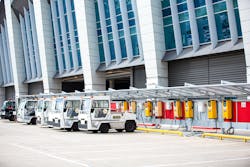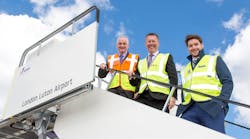The Appeal of Equipment Pooling
Prior to the pandemic, ground support equipment (GSE) pooling was high on the agenda of airports, airlines and ground handling companies, mainly driven by a desire to reduce ramp congestion and improve on-time performance (OTP) at the most optimal total turnaround cost.
“There have been multiple initiatives, the most notable has been Luton Airport, which was one of the first airports we supported to go towards GSE pooling at airport level,” says Kristof Philips, chief operating officer of TCR. “Since the successful go-live, many airports have visited Luton to improve their understanding of how pooling can support their respective ramp operations and help achieve their strategic ambitions.”
Since Luton’s GSE pooling project launched, COVID-19 impacted the aviation space as the world adapted. But Philips says the industry can benefit from pooling post-COVID.
“Many actors on the airport are struggling to reach the right staffing levels to support the aviation ramp-up. Also here, pooling can help by reducing the need to move assets, in case of a stand-allocated approach, resulting in a lower need for ramp staff,” says Philips.
Why Pooling?
Pooling refers to the common use of ground equipment on the ramp. A pooling setup can range from a fully centralized GSE approach, where users pick up and return GSE at/to a central location, or a stand allocated scenario, where GSE is dedicated to a unique stand.
In Luton where ground power units (GPUs), belts and passenger stairs are dedicated to each stand and tractors are shared in zones, TCR implemented a hybrid model, Philips explains.
“Here, the setup is like a pit stop approach in Formula One: when the airplane arrives, they move in; when the airplane leaves, they move out. The benefit is that an asset is always there when needed, improving significantly on-time performance, and reducing congestion as GSE movements are minimized,” he says.
GSE pooling can also be a strong catalyst in support of green projects.
“Having at a single moment in time an aligned strategy in regard to battery choice, GSE fleet and infrastructure allows a quick and smooth green transition. Whereas if every stakeholder has to do it on an individual basis and pace, infrastructure, chargers and GSE fleet mix will result in an almost impossible transition journey stopping it from happening,” says Philips.
GSE Pooling’s Allure
Where pooling is appealing, and which setup is to be considered, needs to be assessed at an individual airport level. However, GSE pooling does not necessarily need to be implemented at an airport level.
“An implementation of a pooling setup in a single terminal or across a set of stands can be equally considered. Each situation is different, and each solution differs case by case,” says Philips.
Magnus Söderberg, business improvement director at Aviator, observes that GSE pooling is more easily accomplished at those airports where there is a dominant GSE lessor providing the equipment.
“The investment mechanism is assumed to be that several ground handlers lease from the same lessor; sharing the equipment result in a smaller fleet, freeing up capital and a more cost-efficient fleet,” he says. “The benefits, apart from the potential financial aspect, are freeing up of space on the apron, resulting in space to invest in infrastructure for the airport. As for ground handlers, freeing up space allows avoiding accidents and damage as well as saving costs.”
“Key for a pooling project to work is the commitment and engagement from all stakeholders involved, including the airport, the airlines, the ground handlers; and the access to an experienced pooling facilitator that has proven experience with running a pooling solution and has an in-depth understanding of GSE as well as ramp operations,” adds Philips.
Another success factor is the clarity in regard to the GSE needs in support of the envisioned flight schedules.
This is important as a pooling project requires a significant capital investment that benefits from maximal/optimal GSE usage reducing the cost per turn, according to Philips.
Benefits of GSE Pooling
The biggest benefit of GSE pooling is for the airlines because the on-time performance improves.
“There are also benefits for the airports from the GSE pooling set-up because airports reduce congestion and complexity and get improved safety standards by gaining control over the assets,” affirms Philips.
The ground handlers benefit from GSE pooling by reducing the complexity of ensuring that all the assets are always where they need to be.
“This way, ground handlers can focus on planning personnel rather than the GSE around the aircraft. Finally, all stakeholders benefit if pooling is used as an enabler to speed up green transition projects,” says Philips.
According to Söderberg, GSE pooling benefits ground handling companies as it allows them to reduce the overall GSE fleet, improve mobility and safety on the apron, and save costs.
“The limitations would concern customer-specific GSE, peak driven equipment and the difference in GSE specifications requirements (e.g., electric vs. diesel ambition), investment appetite, as well as the risk of cooperating/adapting to competing operations,” he says.
GSE Pooling Implementation
When considering a GSE pooling or similar project, there is a need to evaluate the project around three pillars: sustainability, continuity and affordability, according to Philips.
“Sustainability refers to the ‘green’ aspect of the implemented solution. Continuity refers to the access to the main sources of energy that are used to run the GSE fleet. Finally, there is affordability. The latter is a complicated one as pooling is disruptive because benefits and costs do not always lie with the same stakeholder,” he says. “It is, therefore, once more, imperative that the community comes together to assess the total benefit of pooling, and ensures burden and benefit are fairly distributed.”
It could seem logical for an airport to own GSE and run the pooling as it is the airport that owns and/or manages much of the airport infrastructure, observes Philips.
“However, what happens more regularly is that the airport defines the ‘rules of the game,’ and an independent pooling facilitator sets up the pool in line with these instructions. Often pooling setups are a triangular agreement structure meaning that the airport concludes a pooling agreement with the selected pooling facilitator and agrees on an operating permit with the handler/airlines stipulating that common equipment has to be used in support of the ramp operations,” he says.
“The third agreement is the one between the pooling facilitator and the handlers defining the rules of use, specifications, turn price, etc.,” he continues. “At Luton, TCR acted as an integrator taking into consideration all stakeholder and infrastructural needs to ensure the successful pooling of GSE.”







